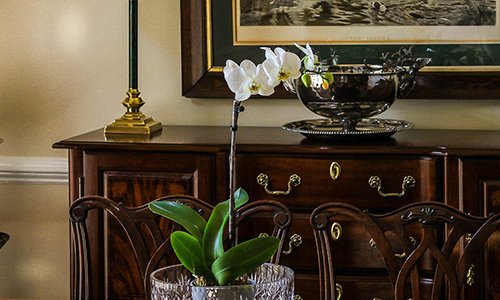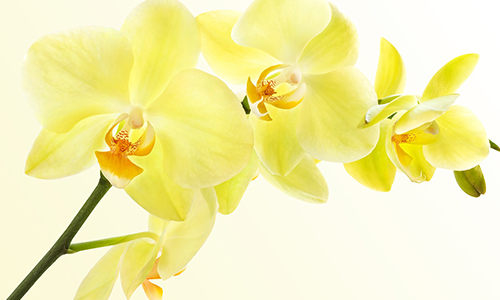Need help incorporating orchids and learning how to keep them alive? Understanding why orchids are so appealing will encourage you to include them in your home’s decor or when staging a home for sale and properly care for them.

asidga.org gathered the following information, ideas, and tips to help you creatively decorate with orchids and give them the care they require to flourish.
Orchids are universally appealing and charming flowering plants, perfect for any room’s decorating and a home’s staging. Orchids are especially appropriate for bathrooms and areas with higher moisture levels. These plants make living spaces appear luxurious and fresh, but growing them indoors requires providing sufficient care and light.
Note: No matter the color, orchids universally symbolize love, beauty, thoughtfulness, fertility, and refinement.

The ideal spot for growing and staging orchids is in the south or east-facing windows. West windows are typically too hot, while northern windows are notoriously too dark. A last resort (if you can’t find a good window location to grow them) is to place your orchids under artificial light.
Orchids are great houseplants, so consider the following staging or growing locations:
Tip: Fluorescent and LED light provide the full light spectrum needed to successfully maintain or grow orchids.
The ideal spot for growing orchids is either south or east-facing windows. Usually, west windows are too hot while northern windows are too dark. Placing orchids under artificial lights is the last resort if you can’t find an adequate location to grow your orchids.
You can find healthy orchids in supermarket flower sections, home improvement garden centers, florist centers, nurseries, and specialty stores. When making your selection, consider the following:
Smell the Plant – Bring the pot close to your nose and inhale. If you detect any foul odors, the plant is rotting.
Inspect Protruding Roots – Above-ground roots are a visible orchid health indicator. They should be among the first things you inspect at the store. Healthy roots are plump and white or green in color (brown, mushy roots indicate overwatering and rot).
Tip: Remove the grower pot from the decorative pot and get a better look at the orchid’s roots.
Bright Green Leaves – Yellow leaves can indicate distress and poor care. But yellow doesn’t always represent trouble. If an orchid’s top leaves are a bright green, but its bottom leaves are yellowing, this is normal. Mature leaves often wither so newer leaves can take their place.
Tip: If all (or most) of an orchid’s leaves are yellowing, the plant is likely dehydrated or overwatered. Yellow spots can indicate an insect infestation. In this case, check the leaves top and bottom for webs or white bumps left by mealy bugs and mites.
Inspect the Blooms – An orchid’s flowers should look healthy and be firmly attached to their spike (slightly jostling the plant will cause weakened blooms to fall).
Tip: Look for a plant with extra buds growing on it. More buds mean more flowers are getting ready to bloom.

Evaluate the Spikes – A spike (stem) must stand tall and support the weight of an orchid’s blooms. (When in full bloom, they can be heavily weighted down). If you notice a stem buckling or severely drooping under the flower’s weight, this signals weak stems.
Now that you have selected an orchid that meets your standards, it is time to care for it. Once you have carefully transported it to your home, consider the following to keep it flourishing:
Light – Bright, indirect light (12 to 14 hours daily) from an eastern or southern window is ideal.
Tip: When using grow lights, place your orchids under your light (4 to 12 inches above your orchid). Allow ample room (adjust the light height when necessary) for flower spikes.
Water Requirements – Water sparingly (once weekly). No orchid variety needs daily watering. Overwatering or poor drainage can lead to disease, rot, and plant death.
Tip: Water your orchids twice weekly during the summer months and in locations with low humidity.
Fertilizer Needs – Orchids should be fertilized once monthly with a 20-20-20 combination containing all necessary trace elements.
Repotting – Orchids should be repotted in late spring (after flowering or when new growth appears) every year or two or when roots push up and out of the pot.
Tip: Store-bought orchids should be repotted the first spring after being purchased.
The following are things you should avoid doing with an orchid:
Note: Orchid roots are part of the “lungs,” and the plant breathes through these aerial roots.
In this article, you discovered how orchids can be staged for home viewings, where they thrive in a home, and how to properly care for them.
Orchids are naturally beautiful and inspiring, significantly and effortlessly improving any room’s decor, ambiance, and appeal.
Improperly caring for, staging, or placing orchids can cause their rapid decline, rotting, and death.
Sources:
warren.cce.cornell.edu/gardening-landscape/warren-county-master-gardener-articles/orchids-as-houseplants
bsu.edu/-/media/www/departmentalcontent/biology/pdf/rinard-orchid-greenhouse/informational-documents/guide-to-orchid-care-and-repotting.pdf?
extension.tennessee.edu/publications/Documents/PB1634.pdf
extension.psu.edu/orchids-as-houseplants
mediafeed.org/these-12-staging-tips-could-help-you-sell-your-home/